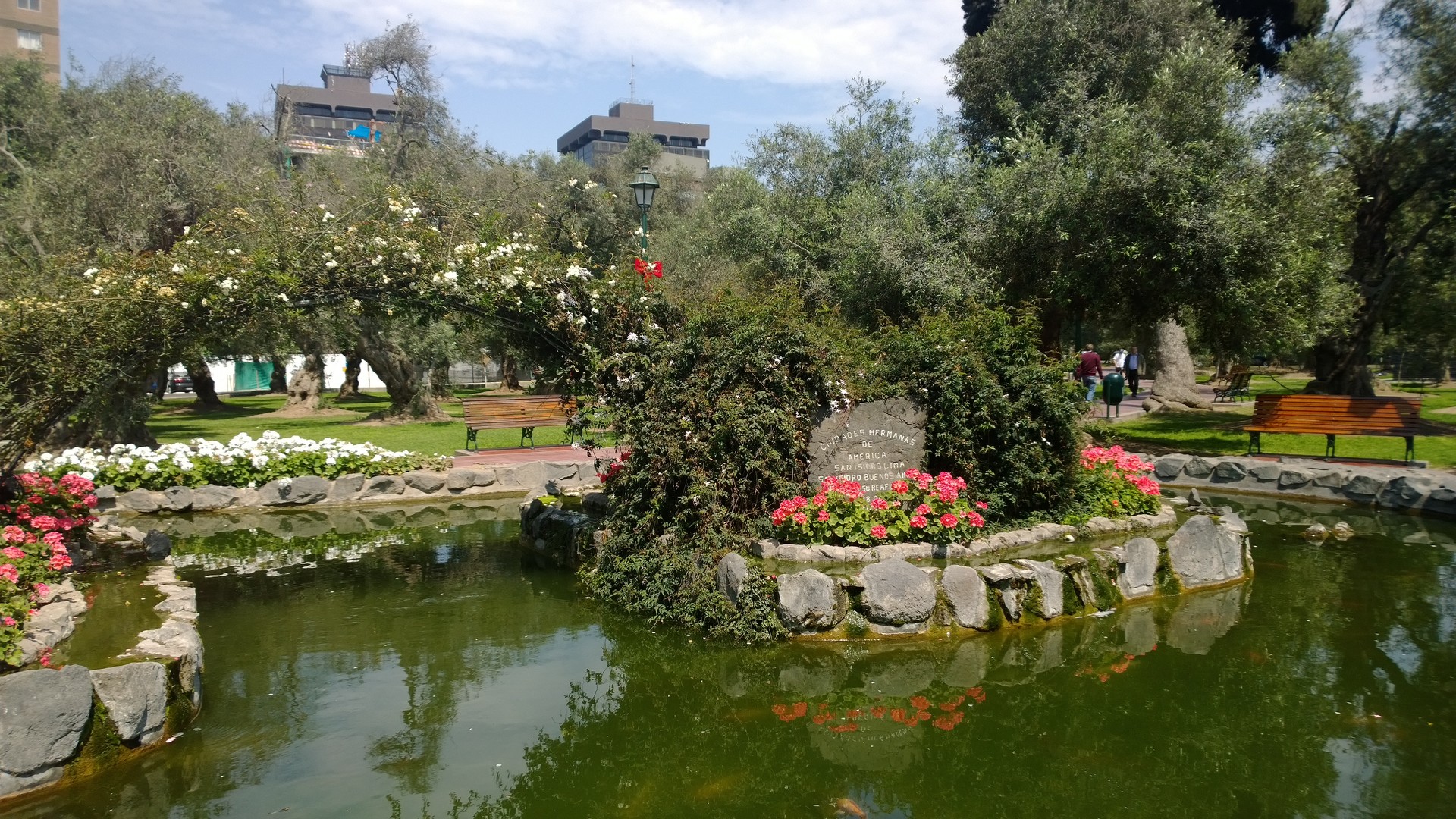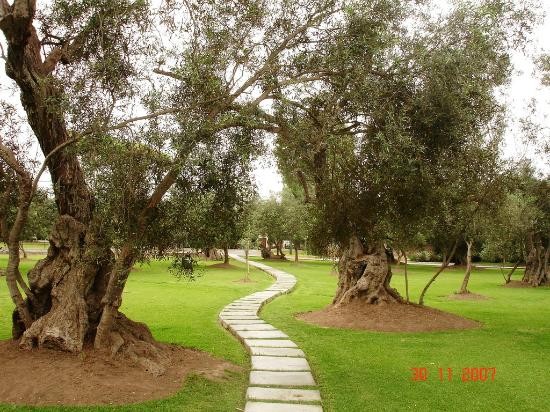Trees with a 400-year-old history
Hello everyone! I hope you are all well. I want to take the opportunity of sharing a beautiful nature spot, located in one of the districts of Lima, Peru. This Parque del Olivar, or the Olive Grove Park, is found in the district of San Isidro, Lima's financial district. Who would expect that, amidst these modern buildings and offices, sits a park from the colonial era?
Views of the park from above

My memories of this wonderful place go back to when I was working in a 5* hotel on the other side of the park. Every day I had to cross the verdant space but as I always liked to be punctual, I never had time to stop and take it all in.
Some time after I had changed jobs to another hotel in San Isidro, I had to look for a place where I could study English, so I applied to the Catholic Language Centre which was very close to the Parque del Olivar. After class I normally had 40 minutes to relax before going to work - what better place to do so than the olive grove with its fascinating history?

When I started my course as a guide at the university I found myself once again at the park. Some of my classmates had developed a route, taking in some of the local attractions in this part of San Isidro. I was also able to recommend the park to the the hotel guests, as the view of the olive trees is simply unique.
An existential crisis
Recently investigators have found that many trees are at risk of dying because they can't coexist with the grass. The grass species growing in the park needs a lot of water, while olive trees are happier in a drier environment. As a result, the tree roots are beginning to rot. The ideal solution for the trees is to take up the grass, leaving simply bare earth as in the colonial times. However, it's not quite so simple; the park is the pride of the neighbourhood and it wouldn't have the same appeal without its lush green carpet.
The solution
With all the troubles concerning the Parque del Olivar, the proposal is to replace the current, 'thirsty' grass with a difference species which needs less water and will give the olive trees a chance to recover.

The Origins of the colonial woodland
To understand the origins of the woodland, we have to journey back in time to the colonial era when Lima was much smaller than it is today - the size of the current historic centre. San Isidro was then a large swathe of agricultural land, situated about 8km from the Plaza de Armas, the main square of Lima. At the time, the olive grove was the largest of its type in the city but as the years passed and the city grew, the grove shrank as it gave in to the encroaching development. Today it covers a mere 87,000 square metres; less than 1km long and 200m wide.
In 1559 a Spaniard called Don Antonio de Ribera brought several thousand olive saplings from Seville to Peru. The saplings were initially planted in a place curiously named the Lost Orchard, and later moved to where they stand today. Nowadays you can find some 1700 olive trees still thriving in the park.
A National Monument
Without a doubt, such a significant natural monument deserved recognition and was declared a National Monument on the 16th December 1959. The community of San Isidro is applying to UNESCO to have the park converted into a heritage site, which will incentivise its continued protection and development for tourism.
A world of birds within the city of Lima
The beauty of the olive grove isn't just in its landscape of gnarled trunks. A wide variety of bird species such as the scarlet flycatcher, saffron finch, blue-gray tanager and even a Harris hawk can be spotted in the leafy canopy above, home to between 25-30 species.
What more is there to see?
This beautiful park is the most representative part of San Isidro and symbolises the two periods of Peru's recent history - the colonial era and post-colonial independence. Nearby you can find the main government buildings and the Cultural Centre "El Olivar" (including the municipal library, children's library, theatre, public hall and gallery) and the 4* hotel El Olivar overlooks the peaceful park.

Within the Parque del Olivar, the remodelled artificial lake stands out from its surroundings, along with the renovated pergola which is a perfect meeting place for family and friends on a day out.
How to get there
To arrive at the Parque del Olivar you can take Avenida Arequipa as your reference. I used to get off the bus at Jirón Choqueahuanca and from there walked eastwards, crossing the park on my way to work. Another option is Avenida Camino Real or Conquistadores, where you will find plenty of designer boutiques and clothes shops. If you have a sweet tooth, you may want to stop at the alfajor shop on the corner, where they sell some of the most delicious alfajores in the city!
Things to think about:
- The park represents 1.7% of the green areas of Lima and Callao.
- There are approximately 1765 olive trees.
- The park covers approximately 23 hectares.
- You can expect to find birds and squirrels amongst the park's wildlife.
- The park is around 4 centuries old.
When you book a tour with an agency such as Limavision, for example, it usually includes a visit to the park including stops to explain Lima's history in the colonial times.
The Olive Tree of Happiness
According to Liman lore, one of the olive trees was planted by the Peruvian saint, San Martin de Porres and is called the Tree of Happiness. It is said that lovers who rest below the tree will always be happy together.
Rivals: visitors vs. locals
I read an article in the La Republica newspaper which was very interesting and tells of the recent controversy of the olive grove. Some residents of San Isidro don't like the fact that people come from all over the city to use the park, and there have been disagreements between the residents and the mayor. Click here for a link to La Republica and recent articles about the Parque del Olivar (Spanish only).
I hope that you have found it interesting to learn more about this hidden gem in modern Lima. It is free, so if you need a break from the bustle of the city, don't hesitate to take a restorative stroll in nature. You will be in the good company of the city's residents!
Thank you very much for reading and I'll see you next time at another of Lima's interesting sights! I hope you have enjoyed it and that you will fall in love with Lima as much as I have! See you soon!
Photo gallery
Content available in other languages
Rate and comment about this place!
Do you know The Olive Grove at San Isidro? Share your opinion about this place.





















